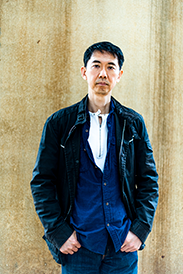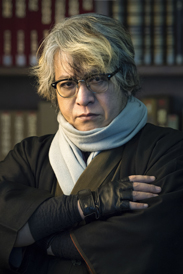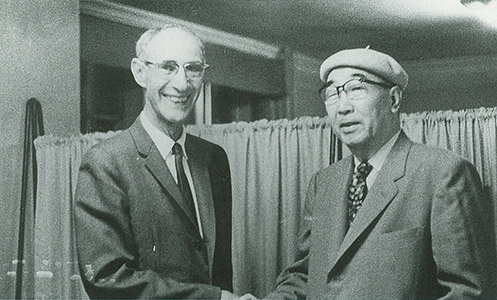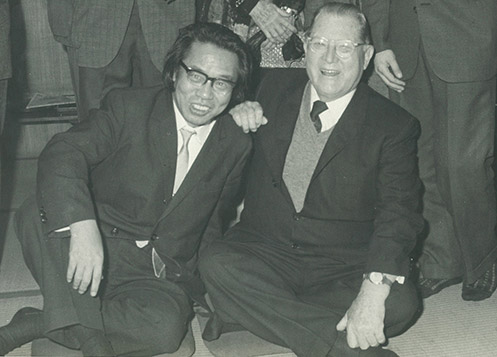President's Message
Thank you for your interest in the Mystery Writers of Japan (MWJ). The MWJ has a history of over 70 years since its establishment. That history is also the history of making Japan take root the mystery, and spreading it.
We have been working to bring mystery novels to readers. The most obvious way to do this is by running the MWJ Award and the Edogawa Rampo Prize. The MWJ Award is given to the best work of the year, and the Edogawa Rampo Prize is a prize that introduces promising new writers to the world. I believe that through the MWJ Award and the Edogawa Rampo Prize, many masterpieces have come to the attention of readers.
The MWJ also aims to deepen friendships among its members, and supports them find like-minded colleagues through stand-up parties and club gatherings.
The Japanese mystery has come a long way and is still evolving and deepening more and more. Of the many novel genres, I (personally) believe that mystery is the most interesting. The MWJ will continue to work hard every day so that our readers can feel the same way. I hope that as many people as possible will come to love mystery.
June 2024
Nukui Tokuro
President
Note: Names are shown in the Japanese order, with surnames first, followed by given names.

Nukui Tokuro
Born in Tokyo in 1968. Debuted with Dokoku (He wailed), which was shortlisted for the 4th Ayukawa Tetsuya Prize. Although it attracted some attention immediately after its release, it did not become a big topic. However, ten years later, it suddenly became a bestseller after receiving recommendations from multiple booksellers. As of 2025, translations are currently underway in eight countries across Europe and America. In 2010, he won the 63rd Mystery Writers of Japan Award for Ranhansha (Diffusion) and the 23rd Yamamoto Shugoro Prize for Kokai to Shinjitsu no Iro (Color of Regret and Truth). Since 2023, he has been the 16th President of the Mystery Writers of Japan.
Translated by Morisawa Kumiko
Message by Former President Kyogoku Natsuhiko
Thank you for visiting our website.
The Mystery Writers of Japan is an incorporated association composed of professionals in the mystery genre including authors, critics, translators, illustrators, book designers, and manga artists, with supporting members such as publishers.
Founded in 1947 by author Edogawa Rampo, who became its first president, it was incorporated in 1963. While originally established with an emphasis on detective fiction, the MWJ has grown and evolved over the years to encompass a broad spectrum of literary entertainment and publishing.
For over 70 years the MWJ has not only provided a forum for members to interact with each other and deepen friendships, but also worked to support the development and appreciation of publishing in all its forms, especially mystery and entertainment literature. The annual Mystery Writers of Japan Award, carried on since our establishment, is a juried prize given each year to outstanding works of long and short fiction and criticism. The Edogawa Rampo Prize for unpublished novels, first offered in 1954, draws on an endowment from Edogawa Rampo himself, and is today recognized as a mark of outstanding promise that has launched many writing careers. In addition, the MWJ edits a series of anthologies, develops publishing plans, and hosts talk shows and other events.
The MWJ is also a place where members, including supporting members, can share information with each other. We apply our strengths to identify issues, provide advice, and help evolve creative and publishing activities to suit the changing era in the recognition that our driving raison d’être is to aid in the publication of as many outstanding works of literature as possible, in the best possible way.
Welcome to the world of the Japanese mystery—I’m sure you’ll enjoy it!
May 2019
Kyogoku Natsuhiko
President
Note: Names are shown in the Japanese order, with surnames first, followed by given names.

Photo MORI Kiyoshi
Kyogoku Natsuhiko
Born 1963 in Hokkaido, Japan. While employed as a designer, Kyogoku submitted a manuscript directly to a publisher, as there were very few literary agents in Japan at the time. It received high praise from the editors, and was published in 1994 as Ubume no natsu (English: The Summer of the Ubume; Vertical, 2009), his debut work. His unique fusion of detective novel and monstrous fantasy received rave reviews. It was shortly followed by Mōryō no hako in 1995 (winner of the Mystery Writers of Japan Award), and a host of other works and awards, including the Naoki Prize. In addition to his first novel, Loups=Garous is also available in English as Loups-Garous (Haikasoru/VIZ Media, 2019). Additional information on his official website, at http://www.osawa-office.co.jp/write/kyogoku.html
Translated by Edward Lipsett
Message by Former President Konno Bin
Thank you for visiting the Mystery Writers of Japan (MWJ) website.
The MWJ brings together authors, critics, translators, illustrators, and other creators working in the mystery genre, and is the oldest organization in the field in Japan. It was born in Tokyo in 1947, as Japan was rebuilding from the destruction of World War II. The man who made it possible was Edogawa Rampo, one of the pioneers in the Japanese mystery literature genre, who became the first head of the MWJ.
Since its establishment, the MWJ has worked to promote mysteries in Japan, nurturing appreciation for works in the field. Its efforts over the years have been successful, and today mysteries are enormously popular in Japan.
One of our most important tasks is managing two leading literary awards, the Edogawa Rampo Prize for unpublished novels, and the Mystery Writers of Japan Award for published works each year.
Edogawa Rampo, the first head of the MWJ, is a pen name for Hirai Taro. He chose the name for its sound, which is similar to Edgar Allan Poe, one of his key literary influences.
The Mystery Writers of Japan will continue to introduce new readers to the joys of mystery fiction.
October 2016
Konno Bin
President
Note: Names are shown in the Japanese order, with surnames first, followed by given names.

Konno Bin
Born 1955, Hokkaido, Japan. Professional writing career from 1978, in a wide range of fields including hard-boiled detective, action, and science fiction, winning acclaim especially with his police procedurals. Major works include the Keishicho Azumi-han series (Chief Azumi, Tokyo Metropolitan Police Department), later developed as a television series under the name Hancho, and the Inpei sosa series (Cover-Up Investigation) focusing on higher-level officers. The latter has won four awards, including the Mystery Writers of Japan Award. Elected president of the Mystery Writers of Japan in 2013. Additional details here:
http://www.booksfromjapan.jp/authors/item/569-bin-konno
Translated by Edward Lipsett
A Brief History of the Mystery Writers of Japan
(Japanese names are shown with surname first.)
-
1) The Beginning
During the Second World War, mysteries were deemed inappropriate for a nation at war, and prohibited. Edogawa Rampo, the most famous author of mystery fiction in Japan when the war ended in 1945 and deemed the most promising by his peers, realized that once Japan was occupied by the United States, where mystery fiction was popular, Japanese fiction would also show significant growth in the genre. Determined to bring together authors, translators, and fans to make it possible, he borrowed a room at Iwaya Shoten, the publisher of Hoseki magazine (one of the first to launch after the war, in April 1946, and the major vehicle for mysteries at the time) for the very first meeting. Held on June 15, 1946, about twenty people attended. Meetings were held on Saturdays once a month after that time, and the budding organization was called the "Saturday Association" as a result.
A year later, at the thirteenth meeting on June 21, 1947, it was announced that the organization had assumed the official name of the Mystery Writers of Japan (MWJ). The first chief director was, of course, Edogawa Rampo himself, and the MWJ was born with 103 members. It defined its goals as "collection, investigation, research, introduction, and publication of domestic and foreign mystery literature and materials related to criminal science," as well as sponsoring the Mystery Writers of Japan Award, and editing and publishing the Mystery Annual of Japan featuring the best short works of the year. The goals remain largely unchanged today.
-
2) The MWJ Award and the Mystery Annual
The first Mystery Writers of Japan Award was held in 1948, and as the first one covered works published in the two-year period from 1946 to 1947. The winners were
- Novel:
- Honjin satsujin jiken (本陣殺人事件; The Distinguished Family Murder Case, or the Haunted Koto) by Yokomizo Seishi (横溝正史)
- Short story:
- "Shingetsu" (新月; Young Moon), by Kigi Takataro (木々高太郎)
- Emerging Writer's Prize:
- "Kaiman-so kidan" (海鰻荘奇談; The Strange Story of Moray Eel Cottage) by Kayama Shigeru (香山滋, a writer of fantastic fiction who authored the original script for Godzilla)
There were no winners for the Emerging Writer's Prize for several years thereafter because the most promising authors – people like Yamada Futaro and Takagi Akimitsu – won awards in the novel or short story categories instead, and eventually that prize was retired. In 1952 Rampo's own Geneijo (幻影城; The Phantom Castle), a collection of literary criticism, became eligible, but no thought had been given to awarding a prize to works of criticism or research, and as a result the decision to grant the award was made by the board of directors instead of the Awards Committee. Initially there was no rule against repeat winners, but in 1952 this was amended to limit each author to a single prize so that as many outstanding authors as possible could be recognized with awards. In 1953, the Awards Committee awarded a special Encouragement Prize, for that year alone. Through this process of growth and development, eventually the Novel and Short story categories were eliminated, and works in any category (novel, collection, short story, criticism, film, etc.) became eligible. This situation persisted even after 1963, when the Club was incorporated.
Two Mystery Annual of Japan volumes were published in 1949, for that year and the preceding one, but since then the rule has called for one volume a year, although publisher and format have changed over the years.
The majority of this activity took place in Tokyo, and in 1948 a similar organization named the Mystery Writers of the Kansai Region (関西探偵作家クラブ) was formed in the Kyoto-Osaka area. It was reorganized as the Kansai Branch of the MWJ in 1954.
-
3) The Edogawa Rampo Prize
In 1954, the traditional sixtieth birthday celebration for Edogawa Rampo was officially sponsored by the MWJ, and in thanks he donated one million yen to the Club as a fund to support the establishment of the Edogawa Rampo Prize. While he named the proposed prize, the specifics of what it would be awarded for were as yet vague. There was no point in duplicating the existing prizes offered by the Club, and so it was given to the literary research of Nakajima Kawataro (中島河太郎) in 1955, the first year it was awarded, and to Hayakawa Publishing Corp. the following year in recognition of the firm's continuing work in publishing mystery works translated from other languages. Rampo, however, wanted it to be awarded to novels, and at the suggestion of Nakajima Kawataro it became a prize for unpublished novels. The third prize was awarded to Niki Etsuko (仁木悦子) for Neko wa shitte ita (猫は知っていた; The Cat Knew Best). The work described the activities of a brother-sister pair of student detectives in a crisp, clear style reminiscent of Agatha Christie, while eliminating the too-common "weird tale" flavor of most pre-War Japanese mystery fiction. It was acclaimed by jurors and readers, and contributed to the establishment of mystery fiction as an independent genre in Japanese literature. Since then the award has been presented over sixty times to diverse authors including Togawa Masako (戸川昌子), Nishimura Kyotaro (西村京太郎), Morimura Seiichi (森村誠一), Higashino Keigo (東野圭吾), Kirino Natsuo (桐野夏生) and Ikeido Jun (池井戸潤). The list of runners-up is equally impressive, and yielded a host of published works by writers such as Sasazawa Saho (笹沢左保), Nakai Hideo (中井英夫), Natsuki Shizuko (夏樹静子), and Shimada Soji (島田荘司).
-
4) Relations with the MWA, and the Road to Incorporation
Edogawa Rampo, the key person in all these activities, also actively exchanged a variety of information with the Mystery Writers of America, becoming a member in 1952. In May 1961, Lawrence Treat, former vice president of the MWA, visited Japan as an official representative of the MWA. Treat was already known to Japanese readers as the father of police procedurals, but strangely enough at the time of his visit only a few of his shorts had been published in Japanese, and only one of his novels since: V as in Victim, in 2001.
Rampo himself referred to the organization as the Mystery Writers of Japan, following the style of its American counterpart, and in 1954 with the amalgamation of the Mystery Writers of the Kansai Region, that English name was formally adopted. Other authors including Kigi Takataro and Matsumoto Seicho (松本清張) also corresponded with European and American authors in the genre on the individual level, but exchanges petered out in the late 1960s.
Rampo invested his own funds to assist the teetering Hoseki mystery magazine, serving as chief editor from 1957–1960, but after a short respite it finally closed in May 1964, ending a run spanning about 250 issues in all.
Rampo himself died in 1965, but before his death worked to incorporate the MWJ to minimize taxation on the Edogawa Rampo Prize Fund. His goal was realized in 1963. The organization's secretariat moved from the premises of Iwaya Shoten into offices made available by Kodansha, the publisher of Edogawa Rampo Prize-winning works and the Mystery Annual.

Edogawa Rampo and Lawrence Treat, in Tokyo (1961)
Photo: Fujisawa Syu -
5) To the Present
Rampo was installed as first president of the MWJ after incorporation, but resigned after less than a year for health reasons. His place was taken by Matsumoto Seicho, a popular author who served for the next eight years. At the request of the third president, Shimada Kazuo (島田一男), Matsumoto also served as chairman until 1975.
The MWJ underwent a variety of changes from 1975. Finances had stabilized, thanks in part to the release of past Mystery Annuals in paperback editions, so the offices were moved from the Kodansha building into the current offices in Aoyama, Tokyo. The MWJ awards were modified into three categories—Novel, Short story, and other works (including criticism and biographies)—which have remained largely unchanged since 1976. In 1982 the bronze of Edgar Allan Poe, which had been used as the Prize, was replaced by a commemorative clock. The "Guess the Killer" reading game offered at the New Year's party and other events were held for the last time in 1977, canceled due to the load imposed on the author and the increase in membership. The character of the organization also changed considerably, from the club-like atmosphere of the early days to a more bureaucratic tone.
In the years since the mystery genre in Japan has produced a host of bestsellers, evolving from a limited niche to a fiction genre read for daily entertainment by the general public. Japanese mystery literature is being translated into other languages, earning high marks overseas. At the same time, however, the development of electronic media has significantly worsened the state of paper-based publishers, and the mystery genre is no exception.
In 1997 a major event was held to commemorate the 50th anniversary of the MWJ and to express our appreciation to our readers, becoming a regular event held every ten years. The MWJ is committed to continuing to drive the development of the genre.
Shimpo Hirohisa, MWJ Director
October 2016
Erle Stanley Gardner with Matsumoto Seicho, the president at the time, in November 1965.
Mr. Gardner visited Japan at the invitation of the US Air Force,
and met with about a dozen Japanese mystery authors at his request for an exchange of views.Chief directors and presidents
- 1947–1952
- 1st chief director Edogawa Rampo
- 1952–1954
- 2nd chief director Oshita Udaru
- 1954–1960
- 3rd chief director Kigi Takataro
- 1960–1963
- 4th chief director Watanabe Keisuke
(Incorporation)
- 1963
- 1st president Edogawa Rampo
- 1963–1971
- 2nd president Matsumoto Seicho
- 1971–1973
- chairman Matsumoto Seicho, 3rd president Shimada Kazuo
- 1973–1975
- chairman Matsumoto Seicho, 4th president Sano Yo
- 1975–1979
- 4th president Sano Yo
- 1979–1981
- 5th president Miyoshi Toru
- 1981–1985
- 6th president Yamamura Masao
- 1985–1989
- 7th president Nakajima Kawataro
- 1989–1993
- 8th president Ikushima Jiro
- 1993–1997
- 9th president Atoda Takashi
- 1997–2001
- 10th president Kitakata Kenzo
- 2001–2005
- 11th president Osaka Go
- 2005–2009
- 12th president Osawa Arimasa
- 2009–2013
- 13th president Higashino Keigo
- 2013-2019
- 14th president Konno Bin
- 2019-present
- 15th president Kyogoku Natsuhiko
Translated by Edward Lipsett